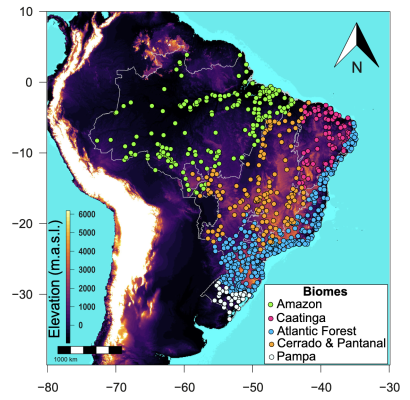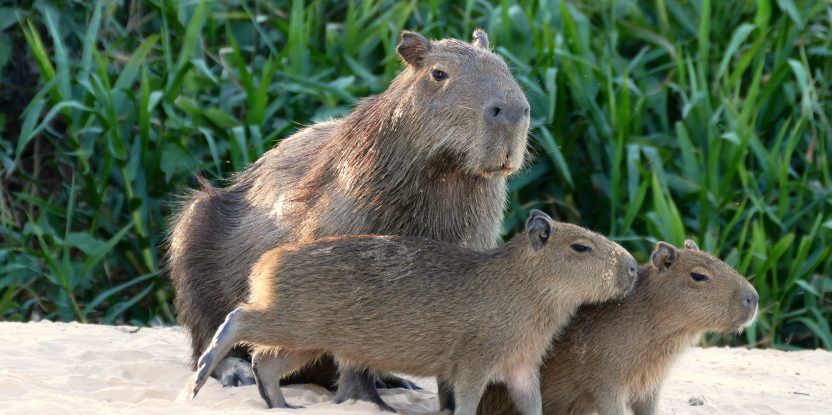Brazil is the most biodiverse country on Earth, with six terrestrial biomes, three marine ecosystems, and at least 103,870 animal species — including the golden lion tamarin, the crab-eating fox and the tapir.
But nature lovers aren’t the only ones interested in the country’s rich fauna: sport hunters also roam the forests — and though not all their harvests are legal, many are not shy about posting them on YouTube and Facebook.
A new study published in Conservation Biology is one of the first to provide systematic data on illegal sport hunting in Brazil using Facebook data. Over two years, researchers reviewed 2,046 posts across five groups. From these, they identified 4,658 illegally hunted animals, representing 157 native species. Nineteen of those species are threatened with extinction. The study also found illegal hunting occurring in all of Brazil’s 27 states and six natural biomes.
Lead author Hani Rocha El Bizri sat down with Forests News to discuss the study’s findings and their importance in promoting sustainable wildlife management in Brazil. El Bizri coordinates the upcoming Transformative Partnership Platform (TPP) on the Sustainable Use of Wild Species, led by the Center for International Forestry Research and World Agroforestry (CIFOR-ICRAF).

Spatial distribution of 2046 hunting events of tetrapods (mammals, birds, reptiles, and amphibians) based on social media data throughout Brazil by biome where hunts presumably took place. The elevational profile is based on data openly available at ASTER Global Digital Elevation
Q: What makes this a groundbreaking study for Brazil?
A: This is one of the first times researchers have used social media to investigate illegal sport hunting. The topic has gained a lot of media attention in Brazil in the past, including from CNN and BBC, but the evidence cited was anecdotal: there was no standardized data collection.
Collecting such data is challenging because it is illegal in Brazil to hunt anything other than the invasive European wild boar [Sus scrofa]. Hunters may fear prosecution and not be honest about harvesting native species.
Because of this, we didn’t know much about the geographical coverage of illegal sport hunting. Was it occurring all over the country? Was it localized? Thanks to our analysis, we now know it is happening almost everywhere: in all biomes and in all Brazilian states. Our estimates are based on monitoring five sport-hunting Facebook groups, through which we linked posts of illegal hunting to 14.2% of the municipalities in Brazil (or 790 in total). There are many more out there, and probably many hunters not posting their harvests, so the spread of illegal hunting is likely underestimated.
Our findings indicate that, in Brazil, banning these activities and relying solely on the current surveillance frameworks to monitor compliance is not very effective.
Q: You said that illegal sport hunting has gained a lot of media attention. What piqued people’s interest?
A: Most social media groups on sport hunting were created in 2018, when former president Jair Bolsonaro won the national election and people seemed to become less afraid of prosecution due to the dismantling of environmental agencies and the president’s rhetoric and actions against the environment. The administration also published a series of decrees that made it easier for collectors, sport shooters and hunters to buy firearms. One of the aims of these loosened regulations was to reduce the population of invasive wild boars, but people noticed that pictures of native species were also appearing in social media hunting groups and on YouTube. The anecdotal evidence seemed to show that at least some of these registered hunters were also using their guns to hunt native species.
Q: Why did you choose Facebook to collect data?
A: We had already published a paper on YouTube and sport hunting in 2015. Even then, I had come across some videos of illegal sport hunting and wanted to understand how social media could be influencing this practice. During the Bolsonaro administration, people began noticing even more illegal sport-hunting videos on YouTube, and we wanted to check if the same kind of situation was present on Facebook.
We also found that Facebook had some benefits over YouTube because it is more community-oriented and provides more comprehensive information. On Facebook, you can more easily form communities where multiple people share their hunting photos and videos, while YouTube channels are usually owned by just one person.
Using Facebook also allowed us to see the users’ locations at the municipality level, which is impossible on YouTube. At most, YouTube videos allowed us to infer which biome the hunting was occurring in, but it was not as precise.
Q: What were some of the challenges you faced?
A: Species identification from pictures can be really difficult to do, especially once the animal is already killed and butchered. When I started this research and began working with CIFOR-ICRAF scientists Lauren Coad and Julia Fa, it was not linked to any overarching project, but we were able to secure some funding through [the UN Environment Programme World Conservation Monitoring Centre’s] TRADEHub. This allowed us to employ three people who could identify birds and reptiles, which were the most difficult. Birds made up a large proportion of the animals that are hunted.
Q: Where does the research go from here?
A: We have been working on another paper in which we analyze the socio-political implications of loosened firearm regulations on hunting native species in Brazil. It’s important to investigate whether the increase in firearm accessibility influenced the illegal sport hunting of native species in Brazil — especially, as I said, considering that these groups were created in 2018 when Bolsonaro won the election.
Q: What impact do you hope this work can have?
A: I think this research paves the way for us to better understand what’s going on with our native fauna, and can inform tailored strategies that specifically address sport hunting. Of course, this will require more research and policy work to know the best way forward.
One of the more controversial possibilities would be regulating and creating sustainable sport hunting programmes that involve local people, as they’ve been shown to be effective in other countries such as South Africa, Zimbabwe and Namibia, and more locally in Uruguay. This should be discussed widely, because our findings show that current regulations are not working to prevent hunting native species. Somehow, we need to find alternatives.
Acknowledgements
This project was funded by the Gordon and Betty Moore Foundation through grant GBMF9258 to the Comunidad de Manejo de Fauna Silvestre en la Amazonía y en Latinoamérica (COMFAUNA) and the UK Research and Innovation’s Global Challenges Research Fund (UKRI GCRF) Trade, Development and the Environment Hub project (ES/S008160/1). We thank the Coordenação de Aperfeiçoamento de Pessoal de Nível Superior – Brasil (CAPES) for a PNPD research fellowship to M.A.O. (88887.717863/2022-00). J.A.B. is supported by a Conselho Nacional de Desenvolvimento Científico e Tecnológico (CNPq) postdoctoral fellowship (150261/2023-3). D.J.I. acknowledges support from UK Research and Innovation (Future Leaders Fellowship grant MR/W006316/1). J.E.F. and L.C. were funded by USAID as part of the Bushmeat Research Initiative of CIFOR-ICRAF.
We want you to share Forests News content, which is licensed under Creative Commons Attribution-NonCommercial-ShareAlike 4.0 International (CC BY-NC-SA 4.0). This means you are free to redistribute our material for non-commercial purposes. All we ask is that you give Forests News appropriate credit and link to the original Forests News content, indicate if changes were made, and distribute your contributions under the same Creative Commons license. You must notify Forests News if you repost, reprint or reuse our materials by contacting forestsnews@cifor-icraf.org.
